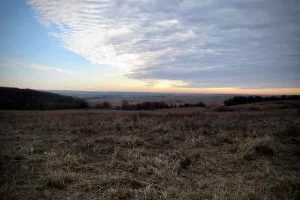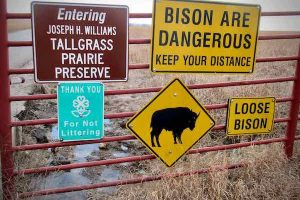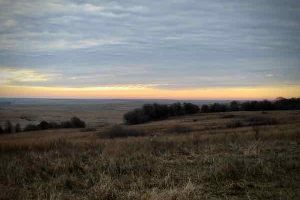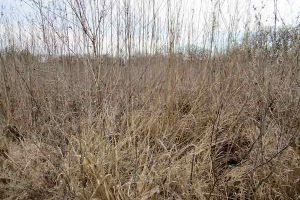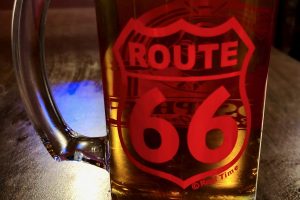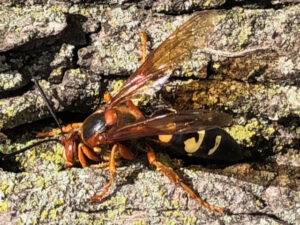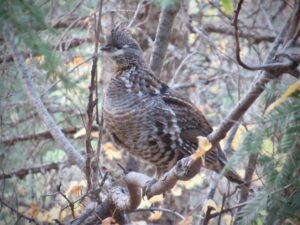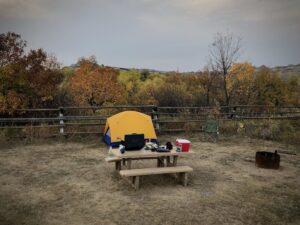
Day 3: Pawhuska, Oklahoma, to Santa Rosa, New Mexico
Distance: 534 miles
Route: OK-18 to OK-11 west to US-64 west to US-54 southwest to I-40 west to Santa Rosa, NM
Highlights: An early morning departure from Pawhuska takes me to 18 miles of dirt road – always interesting in a minivan – and the Joseph H. Williams Tallgrass Prairie Preserve. At 39,650 acres, this is the largest protected area of tall grass left on the planet. I came not for the tall grasses, which grow to more than six feet high, but for the more than 2,500 bison that roam freely here.
It didn’t take long for my first close encounter, as a group of about 20 of the 2,000-pound behemoths blocked the road. One of the markers – not the one that read “Do not exit your vehicle!” – said that bison can jump six feet vertically as well as six feet horizontally. And they can run up to 35 MPH. I watched two calves frolic, running and jumping in circles around the adults and then butting heads.
To think that by one count in 1884 there were only 325 of these magnificent animals left in the United States. Today, there are more than 500,000 of “America’s national mammal,” as declared by former President Obama in 2016 – perhaps his greatest achievement. [TRIGGER]
I crossed paths with three small herds, or gangs, as I made my way to the gift shop and visitor’s center, which I should have known was closed from December 15 to March 1.
The rest of my 534 mile slog west to Santa Rosa, New Mexico, was primarily on the backroads of Oklahoma and Texas. My only companion was the radio, with AM stations dominated by conservative talk [TRIGGER] (nonstop Glenn Beck, Sean Hannity, Rush Limbaugh and Dana Loesch, aka the obnoxious SuperBeets spokeswoman) and FM mostly country but occasionally classic rock. It had been this way since St. Louis, with brief interludes of NPR. [TRIGGER]
I was tooling along OK-11, which I picked up at Shidler. I crossed the expansive Arkansas River, through Kaw City, Blackwell, Nardin, Deer Creek and Medford. After that came the Salt Plains National Wildlife Refuge, Ingersoll, Ashley and Alva, home to the “drug offender work camp,” aka the Charles E. Bill Johnson Correctional Center, which specializes in the rehabilitation of young and nonviolent offenders. [TRIGGER] It’s the only one of its kind in Oklahoma.
After Alva, OK-11 becomes US-64. Then it’s Buffalo, Rosston and Gate, home of the Gateway to the Panhandle Museum. In Forgan, I learned about the spectacularly popular Hank the Cowdog, a working ranch pooch who inspired the more than 70 children’s books by Texas author John Erickson. First Pioneer Woman. [TRIGGER] Then Hank the Cowdog. I am totally clueless.
In Turpin (population 477), there was a sign recognizing the local high school football team, the Cardinals. This was a common sight as I passed though dusty town after dusty town – tons of civic pride in the local high schools, undoubtedly the only team in town.
Next came Hooker, [TRIGGER] where I turned onto US-54 southwest and laughed as I passed signs for the Hooker Chamber of Commerce and the Hooker Gift Shop and the Hooker Inn.
Apparently the entire town is in on the gag, as the gift shop sells T-shirts that read “Support your local hookers,” “A location not a vocation” and “Once a hooker, always a hooker.” Apparently, the town elders never got the memo, because their website features young girls and boys as models for all the hooker paraphernalia. [TRIGGER] Not kidding.
Anyway, moving right along, I’m always interested in where people work in these small towns. In Hooker, there was the TCEC, the Tri-County Electric Cooperative, which provides electrical service to residents of the Oklahoma panhandle. Down the road, in Guymon, it was a food processing plant for Seaboard Co., the second largest pig producer [TRIGGER] and fourth largest pork processor [TRIGGER] in the United States. Their website says the Guymon facility processes [TRIGGER] more than 6 million market hogs per year – and more than 4 million pounds of both edible and inedible products … every … single … day. [TRIGGER] I don’t even want to know what the inedible products are.
Then it’s on to Goodwill, the border town Texhoma and across the state line into Texas with Stratford and Dalhart, home of the XIT Museum, which celebrates the history and culture of Dallam and Hartley counties and the once ubiquitous 3 million (!) acre XIT ranch. An XIT land deal ultimately paid for the construction of the Texas state capital in Austin. [TRIGGER]
Make no mistake, this part of the route is the epicenter of ranch country – Texas (4.65 million head in 2019) and Oklahoma (2.15 million) have the most beef cattle. [TRIGGER] And I passed no less then three massive feed lots (aka “cow death camps”) [TRIGGER], where tens of thousands of black Angus await their fate [TRIGGER] (see photo below) [TRIGGER]. I’ve never seen anything like it and I hope I will to never see anything like it again. [TRIGGER]
Literally, as I was driving, a mysterious giant sea of black appeared on the horizon. As I got closer, it becomes clear: The black is alive [TRIGGER] – an uninterrupted mile of Angus, with little single file ramps up to the railway. I open the window to take a photo. It took 30 minutes for the stench to fade. [TRIGGER]
With those images etched permanently in my mind, I make my way back onto I-40 for the last stretch of the day and an overnight at the fabulous EconoLodge [TRIGGER] back on historic Route 66. [TRIGGER]
There would be no meat on the table tonight. [TRIGGER]


